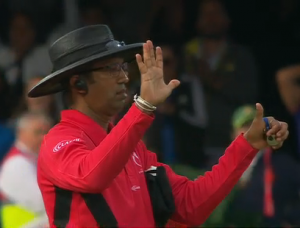Overthrow or wilful act of fielder - Laws of Cricket
|
Cricket Anatomy™
Law 18.12.2 (Batsman returning to wicket he/she has left) shall apply as from the instant of the throw or act.
view template
|
Yesterday’s enrapturing Cricket world cup final threw up a key decision, when, three balls from the end of the match, Martin Guptill’s throw from deep-midwicket, which was going to direct hit and run Ben Stokes out[1], cannoned off the back of Stokes’ flailing bat as he dived desperately to get anywhere near the crease before it did, and ran down and over the boundary for overthrows.
With haste which might transpire to be unseemly, Umpire Dharmasena held up six fingers: Four runs for the overthrow and two for the runs the outfield batsmen completed. But a quick look at Law 19.8 tells a different story.
- ↑ Prove it wouldn’t have okay?
